NCERT Exemplar Solutions for Class 9 Science Chapter 5 The Fundamental Unit of Life
These Solutions are part of NCERT Exemplar Solutions for Class 9 Science . Here we have given NCERT Exemplar Solutions for Class 9 Science Chapter 5 The Fundamental Unit of Life
Question 1.
Why are lysosomes known as “suicide bags” of a cell ?
Answer:
Lysosomes contain digestive enzymes against all types of organic materials. If their covering membrane breaks as it happens during injury to cell, the digestive enzymes will spill over the cell contents and digest the same. As lysosomes are organelles which on bursting can kill the cells possessing them, they are called suicide bags.
More Resources
- NCERT Exemplar Solutions for Class 9 Science
- NCERT Solutions for Class 9 Science
- Value Based Questions in Science for Class 9
- HOTS Questions for Class 9 Science
- Previous Year Question Papers for CBSE Class 9 Science
Question 2.
Do you agree that “A cell is a building unit of an organism” ?
Answer:
Yes. Cell is a building unit of every living organism as every living being is made up of one or more cells. In unicellular or acellular organisms, the single cell performs all the functions of life. In multicellular organisms all the cells have a similar basic structure and perform similar basic life activities. However, they become specialised to form components of different structures that perform different functions. Cells are first organised into tissues, each with a specific function, e.g., contraction by muscular
tissue. Tissues are organised to form organs with each organ performing a specific fonction, e.g., heart, stomach, kidney. Organs are grouped into organ systems, each with a major fonction, e.g., circulatory system, excretory system, respiratory system. A living being has a number of organ systems. However, in all such organisational complexity, cell remains the basic building unit of the organism.
Question 3.
Why does the skin of your fingers shrink when you wash clothes for a long time ?
Answer:
Clothes are washed with soap or detergent solution. This solution is hypertonic as composed to osmotic concentration of our skin cells. The washing solution, therefore, causes exosmosis in the skin cells that come in contact with it for some time. Because of it, the skin over the fingers shrinks while washing clothes for a long time.
Question 4.
Why is endocytosis found in animals only ? (CCE 2012)
Answer:
Endocytosis is engulfment of food and other substances from external medium by plasma membrane. This is possible only when plasma membrane is in direct contact with external medium. It occurs only in animal cells. In plant cells, a cell wall is present over the plasma membrane. Therefore, their plasma membrane cannot perform endocytosis.
Question 5.
A person takes concentrated solution of salt. After some time he starts vomiting. What is the phenomenon responsible for such a situation ? Explain.
Answer:
Concentrated salt solution causes irritation and excessive dehydration in the wall of alimentary canal due to exosmosis. There is uncomfortable stretching which causes reverse movements and hence vomiting.
Question 6.
Name any cell organelle which is non-membranous.
Answer:
Ribosome.
Question 7.
We eat food composed of all the nutrients like carbohydrates, proteins, fats, vitamins, minerals and water. After digestion, they are absorbed in the form of glucose, amino acids, fatty acids, glycerol, etc. What mechanisms are involved in the absorption of digested food and water ?
Answer:
Digested Food :
- Glucose, amino acids and some ions — Active transport.
- Fatty acids, Glycerol — Diffusion (Passive transport).
Water : Osmosis.
Question 8.
If you are provided with some vegetables to cook, you genenrally add salt into vegetables during cooking process. After adding salt, vegetables release water. What mechanism is responsible for this ? (CCE 2014)
Answer:
On adding salt, vegetables release water due to exosmosis. Exosmosis occurs whenever the external medium is hypertonic as compared to the osmotic concentration inside living cells.
Question 9.
If cells of Onion peel and RBC are separately kept in hypotonic solution what among the following will take place ? Explain the reason for your answer,
(a) Both the cells will swell
(b) RBC will burst easily while cells of Onion peel will resist the bursting to some extent
(c) a and b both are correct
(d) RBC and Onion peel cells will behave similarly.
Answer:
(b) RBC will burst as there is no mechanism to restrict entry of water into them. Onion peel cells do not burst. Endosmosis causes some initial swelling but cell wall puts a mechanical barrier to further swelling and entry of water. Therefore, they do not burst.
Question 10.
Bacteria do not have chloroplast but some bacteria are photoautotrophic in nature and perform photosynthesis. Which part of bacterial cell performs this ?
Answer:
Photoautotrophic bacteria posses photosynthetic pigments inside small vesicles which may be attached to the plasma membrane.
Question 11.
Match the items of A and B.

Answer:
a —iv, b —v, c —iii, d —i, e —ii
Question 12.
Write the name of different plant parts in which chloroplast, chromoplast and leucoplast are present.
Answer:
- Chromoplast : Flower (petals) and fruits
- Chloroplast : Green leaves and green parts of young stems.
- Leucoplast : Root and underground stem .
Question 13.
Name the organelles which show analogy written as under
(a) Transporting channels of the cell
(b) Power house of the cell
(c) Packaging and despatching unit of the cell
(d) Digestive bag of the cell
(e) Storage sac of the cell
(f) Kitchen of the cell
(g) Control room of the cell
Answer:
(a) Endoplasmic reticulum
(b) Mitochondria
(c) Golgi apparatus
(d) Lysosome
(e) Vacuole
(f) Chloroplast
(g) Nucleus.
Question 14.
How is bacterial cell different from an Onion peel cell ?
Answer:
See differences between prokaryotic (bacterial cell) and eukaryotic (Onion peel cell) cells.
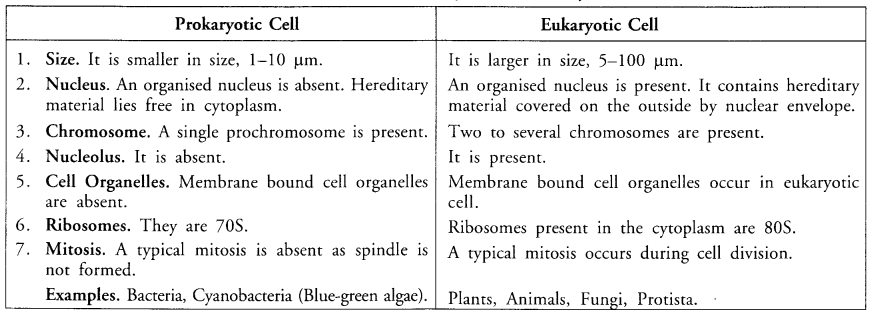
Question 15.
How do substance like carbon dioxide and water move in and out of the cell ?
Answer:
CO2 moves into and out of cells by diffusion while water does it through osmosis.
Diffusion. It is movement of particles of various substances from the region of their higher concentration to the region of their lower concentration,
- In a respiring cell, more CO2 is produced internally. As a result its internal concentration rises. As concentration of CO2 is lower in the outside medium, CO2 passes out from cell into external medium,
- In photosynthetic cell, CO2 is being consumed in photosynthesis. Its intracellular concentration is lower than outside medium. Therefore, CO2 diffuses from outside to inside of the cell.
Question 16.
How does Amoeba obtain its food ?
Answer:
Plasma membrane of Amoeba is flexible. With its help, Amoeba engulfs food particle. The engulfed food particle passes into the body of Amoeba as a phagosome. Phagosome combines with lysosome to produce digestive or food vacuole. Digestion occurs in food vacuole. The digested food passes into surrounding cytoplasm. The undigested matter is thrown out of the cell in exocytosis.
Question 17.
Name two organelles in the plant cell that contain their own genetic materials and ribosomes.
Answer:
- Plastids
- Mitochondria.
Question 18.
Why are lysosomes also known as “scavengers—waste disposal system of the cell ?” (CCE 2011)
Answer:
Lysosomes are called scavengers of the cell because they remove cell debris consisting of dead and worn out cell organelles by digesting the same. For this, they possess powerful digestive enzymes capable of breaking down all organic nutrients. Lysosomes also.nourish the cells by sending out digested nutrients into the cytoplasm.
Question 19.
Which cell organelle controls most of the activities of the cell ?
Answer:
Nucleus, by controlling metabolism and cell activities. Genes express their effect through RNAs. RNAs control synthesis of proteins and enzymes.
Question 20.
Which kind of plastid is more common in
(a) Root of the plant
(b) Leaves of the plant
(c) Flowers and fruits ?
Answer:
(a) Roots : Leucoplasts
(b) Leaves : Chloroplasts
(c) Flowers and Fruits : Chromoplasts.
Question 21.
Why do plant cells possess large sized vacuole ? (CCE 2011)
Answer:
Vacuole of plant cells has to be large because it takes part in
- Storage : It stores salts, sugar, amino acids, organic acids and some proteins.
- Cellular Wastes : They are dumped in the vacuole.
- Lysosomal Enzymes : They occur in the vacuole of plant cells.
- Turgidity : The vacuole contains cell sap which provides turgidity to the cells.
- Absorption of Water : Plant cell vacuole contains an osmotic concentration required for absorption of water.
Question 22.
How are chromatin, chromatid and chromosomes related to each other ? (CCE 2012)
Answer:
Chromatin is intertwined mass of fine thread like structures made of DNA and protein. During cell division, chromatin condenses to form thicker rod like structures called chromosomes. Each chromosome consists of two similar halves called chromatids. Formation of chromosomes having two similar halves or chromatids is meant for equitable distribution of chromatin which is hereditary material.
Question 23.
What are consequences of the following conditions ?
- A cell containing higher water concentration than the surrounding medium.
- cell having low water concentration as compared to its surrounding medium.
- A cell having equal water concentration to its surrounding medium.
Answer:
High water concentration occurs in hypotonic solution, low water concentration in hypertonic solution while equal water concentration occurs in isotonic solution.
- A cell having higher water content or hypotonic cell sap will undergo exosmosis and therefore, lose water. It may undergo plasmolysis.
- A cell having low water concentration or hypertonic cell sap will undergo endosmosis and absorb water from outside. It would become turgid.
- A cell having isotonic cell sap will neither gain or lose water to the external medium.
Question 24.
Draw a plant cell and label the parts which
- Determine function and development of the cell.
- Provides resistance to microbes and to withstand hypotonic external medium without injury.
- Packages materials coming from the endoplasmic reticulum.
- Is a fluid contained inside the nucleus.
- Is site for many biochemical reactions necessary to sustain life.
Answer:
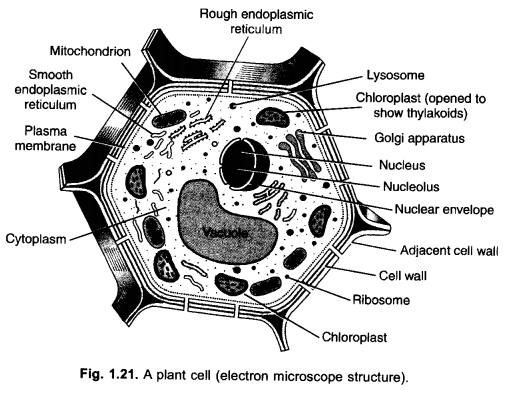
- Nucleus
- Cell wall
- Golgi apparatus
- Nucleoplasm
- Cytoplasm.
Question 25.
Illustrate only a plant cell as seen under electron microscope. How is it different from animal cell ?
Answer:
(a)

(b) Differences between Plant and Animal Cells.
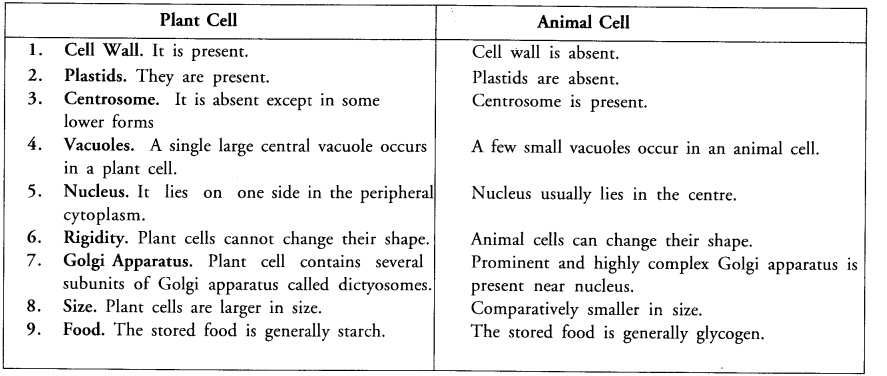
Question 26.
Draw a neat labelled diagram of an animal cell.
Answer:
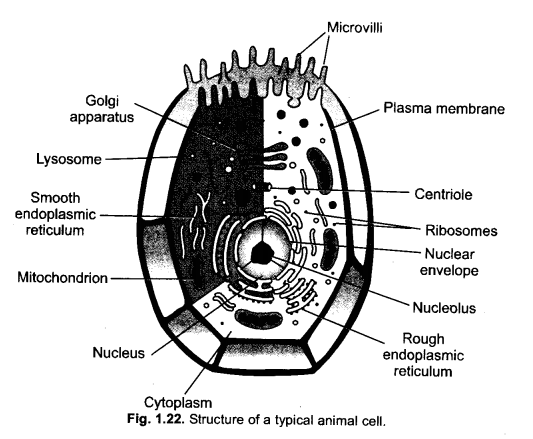
Question 27.
Draw a well labelled diagram of eukaryotic nucleus. How is it different from nucloid ?
Answer:
(a)
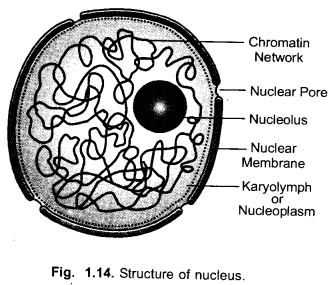
(b) Differences between Nucleus and Nucleoid

Question 28.
Differentiate between rough and smooth endoplasmic recticulum. How is endoplasmic reticulum important for membrane biosynthesis ?
Answer:
(a) Differences.
 (b) Membrane Biosynthesis : Both the types of E.R. take part in membrane biosynthesis. Rough endoplasmic reticulum synthesises proteins which are passed over to Golgi apparatus for glycolisation. Smooth endoplasmic reticulum forms lipids over its surface. They are also transported to Golgi apparatus. Golgi apparatus builds membrane with the help of lipids and proteins.
(b) Membrane Biosynthesis : Both the types of E.R. take part in membrane biosynthesis. Rough endoplasmic reticulum synthesises proteins which are passed over to Golgi apparatus for glycolisation. Smooth endoplasmic reticulum forms lipids over its surface. They are also transported to Golgi apparatus. Golgi apparatus builds membrane with the help of lipids and proteins.
Question 29.
In brief, state what happens when
- Dry apricots are left for some time in pure water and later transferred to sugar solution.
- A red blood cell is kept in concentrated salt solution.
- The plasma membrane of a cell breaks down.
- Rheo leaves are boiled in water first and then drop of sugar syrup is put on it.
- Golgi apparatus is removed from the cell.
Answer:
- When placed in pure water, dry apricots swell up the due to endosmosis. On being transferred to sugar solution, they shrink due to exosmosis.
- In concentrated salt solution, red blood cell will shrink and give a shrivelled appearance (crenation).
- Breakdown of plasma membrane will result in death of the cell as protoplasmic structures will get dispersed.
- Boiling shall kill the leaves. The dead leaves and their cells do not undergo plasmolysis.
- Formation of lysosomes, secretory and excretory vesicles will stop.
Question 30.
Draw a neat diagram of plant cell and label any three parts which differentiate it from animal cell.
Answer:
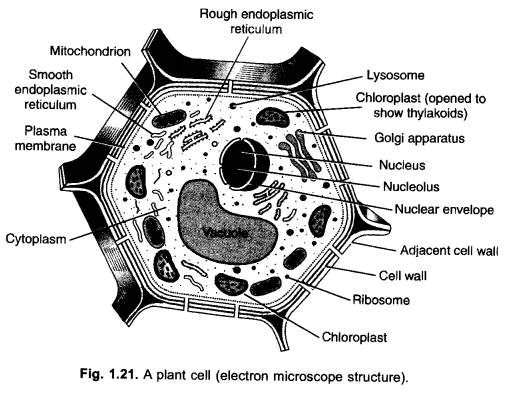
Show chloroplast, large vacuole and cell wall. The three do not occur in the animal cell.
Hope given NCERT Exemplar Solutions for Class 9 Science Chapter 5 The Fundamental Unit of Life are helpful to complete your science homework.
If you have any doubts, please comment below. Learn Insta try to provide online science tutoring for you.